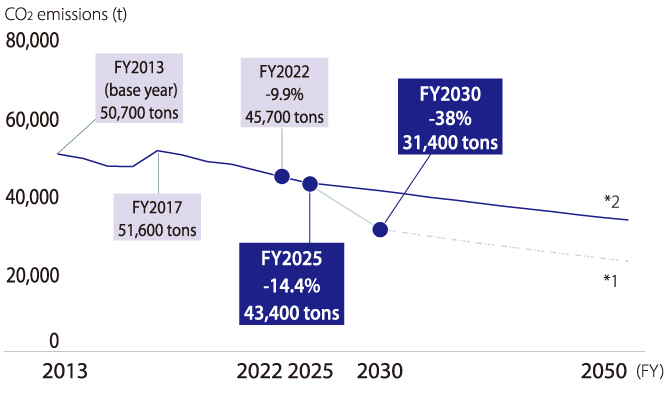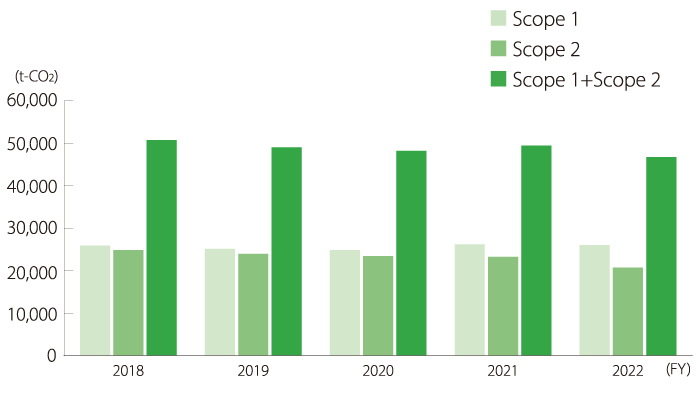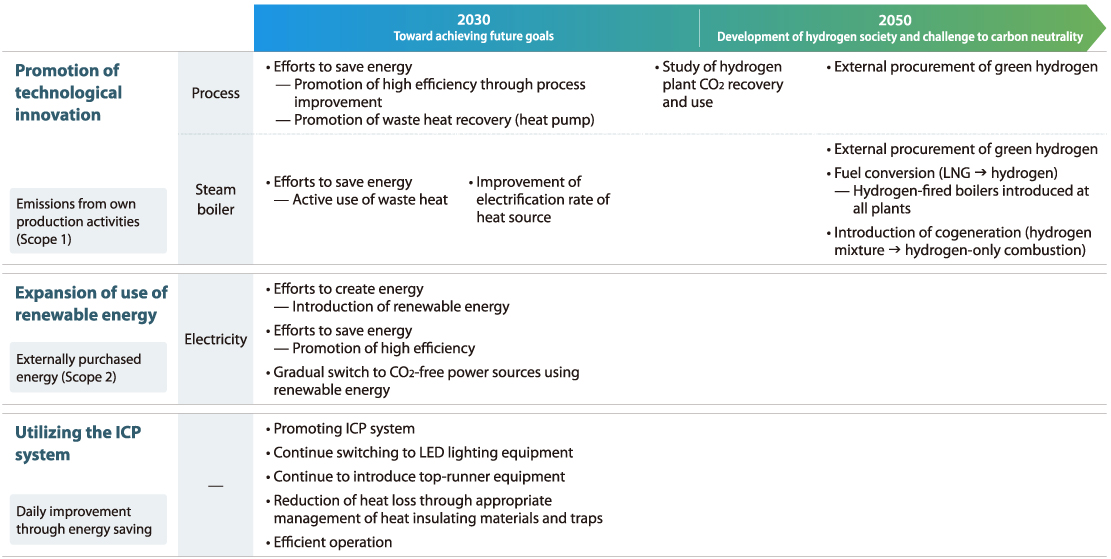

In recent years, social issues, including climate change, have worsened at a global level, necessitating sustainability management. Under such circumstances, the Hodogaya Chemical Group is committed to achieving the realization of a sustainable environment and society as specified in the VISION (“Target Corporate Image”) in the mid‑term management plan SPEED 25/30 effective since FY2021, adhering to the concept of “balancing the pursuit of economic interest and solutions to social issues and providing value to all stakeholders.”
The VISION (“Target Corporate Image”) under SPEED 25/30 is “a corporation that contributes to establish a sustainable society by means of our original portfolio and environmentally friendly manufacturing, with a focus on specialty products” and we position mid‑ to long‑term sustainability, including the elements of ESG, as a crucial management challenge.
In relation to the TCFD recommendations, as a chemical company, we take climate change seriously, strive to conduct initiatives to solve it, and promote information disclosure.
The Sustainability Development Committee is a committee organization that actively promotes responsibility toward the realization of a sustainable earth and society in accordance with the “Management Philosophy” and “Corporate Action Guidelines.” We reorganized our existing CSR Committee as the Sustainability Development Committee and established the Global Environment Subcommittee, which promotes activities related to preservation and improvement of the global environment, and the TCFD Subcommittee, which promotes disclosure activities in response to guidance from the TCFD, in addition to the conventional RC/QM Subcommittee.
The Risk Management Committee discusses companywide risk recognition, evaluation and mitigation measures. The Risk Management Committee also discuss environmental risks, such as climate-related risks, opportunities and countermeasures recognized by the TCFD Subcommittee.
The content of discussions in each committee and subcommittee is submitted and reported to the Board of Directors and Management Committee.

Our purpose is to contribute to the creation of an environmentally conscious society through constant innovation in response to social changes. Reducing greenhouse gas emissions has been an urgent issue requiring global effort since the Paris Agreement was adopted in 2015, and the Hodogaya Chemical Group has been committed to reducing these emissions for many years. We successfully reduced CO2 emissions from 211K tons to 48K tons (i.e., by approx. 75%) over 30 years from FY1990 to FY2020 by implementing various measures such as the promotion of fuel conversion at our plants.
We forecast an increase in production volume as “constructing a new business portfolio,” which is the business strategy roadmap of the current mid‑term management plan SPEED 25/30, is promoted; therefore, we have classified foreseeable risks into TCFD risk categories from the long-term viewpoint, targeting 2030 according to our climate scenario analysis. We have analyzed the risk of achieving a carbon-free society as “1.5℃ Scenario,” and the risk due to intensifying climate change as “4℃ Scenario.” Based on the results of these scenario analyses, we will promote new initiatives to respond to transitional and physical risks.
| 1.5°C scenario |
|
| 4°C scenario |
|
| Risks and Opportunities | Risk | Opportunities | Measures | Impact on business | ||
|---|---|---|---|---|---|---|
| Transitional risk 1.5°C scenario | ||||||
| Policy/ Regulation |
|
〇 |
|
Increase in energy costs and raw material procurement costs due to the introduction of a carbon tax, etc. | ||
| Strengthening environment management | 〇 | Strengthen the internal structure by leveraging the knowledge gained thus far | Increased cost burden for maintenance and improvement of management system | |||
| Technology | Creation of new technologies for environmental friendliness | 〇 | 〇 |
|
[Risk] Increase in R&D and manufacturing costs [Opportunity] Maintain and expand market share by providing products and services that meet demand |
|
| Market | Eco-friendly market formation | 〇 | 〇 | Revise and strengthen business strategies by deepening market and customer needs, and improve R&D and manufacturing technology capabilities corresponding to them | [Risk] Increase in R&D and manufacturing costs [Opportunity] Maintain and expand market share by providing products and services that meet demand |
|
| Reputation | Stakeholders making environment as important matters | 〇 | 〇 | Enhancing dialogue with local communities, personnel, and shareholders and securing a system | ー | |
| Physical risk 4°C scenario | ||||||
| Chronic | Rise in average temperature | 〇 | 〇 | Labor saving and automation of manufacturing equipment | [Risks and Opportunities] Response to market changes, especially in the agrochemicals business |
|
| Acute | Increase in earthquakes, typhoons, and floods | 〇 | Promote multiple purchases, strengthen BCP | Shutting down of factories and inability to procure raw materials | ||
| Segment | Opportunity |
|---|---|
| Functional Colorants Segment |
|
| Specialty Polymers Segment |
|
| Basic Chemicals Segment |
|
| Agro-Science Segment |
|
The Hodogaya Chemical Group has set the following non-financial targets (climate change-related) for FY2025 in its Mid-term Management Plan SPEED25/30.
• Reduction of CO2 emissions
• Reduction of energy intensity
• Industrial waste volume reduction
Regarding CO2 emissions, we have set targets for both volume and intensity reductions, taking into account changes in emissions due to increases and decreases in production volume. These are examined by the Global Environment Subcommittee, discussed by the Sustainability Development Committee, and progress is confirmed by the Board of Directors and Management Committee.
| Non-financial targets | FY2021 results | FY2022 results | FY2025 management targets |
|---|---|---|---|
| CO2 emissions (CO2 emission intensity) |
49,247t-CO2 (1.1759t-CO2/million JPY of net sales) |
45,722t-CO2 (1.055t-CO2/million JPY of net sales) |
43,300t-CO2 (0.868t-CO2/million JPY of net sales) |
| Energy intensity (per million JPY of net sales) |
0.698kl | 0.636kl | 0.606kl |
| Industrial waste volumes | 2,746t | 3,477t | Same level or less than previous FY |
Most of the greenhouse gases (GHG) emitted by Hodogaya Chemical are energy-derived CO2. GHG emissions in FY2022 are approximately 46,000 t-CO2 (SCOPE 1*1 + SCOPE 2*2). As production is expected to increase in the future, we will address climate change from both mitigation and adaptation perspectives and from a long-term perspective looking toward FY2030.
To promote CO2 reduction, in addition to Hodogaya Chemical’s technology, we are considering the introduction of Internal Carbon Pricing (ICP) in FY2021. It will allow us to price our own carbon emissions along with energy saving and energy creation initiatives and renewable energy. Hodogaya Chemical is aiming for a 38% reduction in FY2030 by creating a system that can support investment as a response to climate change toward a low-carbon society.
*1 Scope 1: Direct emissions
*2 Scope 2: Energy-originated indirect emissions

*1 The dotted line after FY2030 is an unconfirmed value.
*2 The solid line after FY2025 is the expected decrease of 1% from the previous year.

